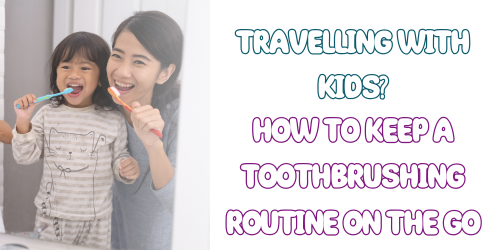Summer holidays are an exciting time for families—filled with new places, fun activities, and a much-needed break from the usual routine. But if you're traveling with a child, especially one who is neurodivergent (such as autistic or ADHD), even small changes can feel overwhelming. One daily habit that can easily get derailed is toothbrushing.
While skipping a brushing here and there might seem harmless, routine is especially important for neurodivergent children. Many find comfort and security in knowing what to expect, and maintaining oral hygiene is essential for long-term health and self-esteem.
Here are some practical, compassionate strategies to help you support your child’s brushing routine while traveling this summer:
1. Start Preparing Before You Go
The more familiar the experience feels, the less stressful it will be.
Use Visual Schedules: Create a simple visual checklist or schedule that includes brushing teeth at the same time each day. Include images of travel elements (suitcases, hotel rooms) to bridge the gap between home and holiday.
Social Stories: These are personalized, short stories that walk your child through what to expect. For example: “Even though we are in a hotel, I will still brush my teeth after breakfast and before bed. I can use my toothbrush from home. Mum or Dad will help if I need it.”
2. Bring Familiar Items from Home
Familiar tools = less sensory overload.
Same Toothbrush and Toothpaste: If your child has a preferred brush or flavour of toothpaste, don’t risk trying a new one on holiday. Bring enough supplies for the whole trip.
Toothbrushing Timer or App: Many neurodivergent kids respond well to structure and feedback. Pack a sand timer, visual timer, or use an app that plays music for two minutes.
3. Create a "Brushing Station"
Turn any new bathroom into a comfort zone.
Set Up a Routine Spot: Once you arrive, lay out the toothbrush, paste, and any supports (mirrors, timers, step stools) in a consistent place.
Lighting & Sound Adjustments: Some hotel bathrooms have harsh lighting or loud fans. If your child is sensitive, bring a nightlight or small lamp, and let them brush in a quieter spot if needed—yes, even in the bedroom if that works better!
4. Stick to Routine When Possible (But Flex Gently)
Aim for consistency without rigidity.
Keep the Times Predictable: Try to brush at roughly the same time as at home. This helps anchor the day in familiarity.
Don’t Worry if It’s Not Perfect: If your child resists or misses a session, it’s okay. Try again the next day. Traveling is already a big adjustment—be kind to them and yourself.
5. Make It Fun (Especially When You're Somewhere New)
Brush with a View: If you’re camping or staying somewhere scenic, invite your child to brush outside or near a window—turn it into a mini adventure.
Reward Charts or Stickers: Bring a small travel version of a reward chart or use stickers for each successful brushing session.
6. Use Gentle Reminders and Reinforcement
Children—especially neurodivergent ones—thrive with positive reinforcement and clarity.
Give Countdown Warnings: Let them know brushing time is coming (“Five more minutes until we brush!”).
Praise Their Efforts: “You remembered to brush even in a new place. That’s awesome!” Focus on effort, not perfection.
Final Thoughts
Traveling with a neurodivergent child means being flexible, prepared, and attuned to their needs. Toothbrushing might seem like a small thing, but keeping that routine intact can give your child a sense of control and stability in the midst of exciting (and sometimes overwhelming) changes.
By thinking ahead, packing smart, and creating a supportive routine wherever you go, you’re setting your child—and yourself—up for a smoother, happier holiday.
Bonus Packing Checklist for Brushing on the Go:
✅ Child’s favourite toothbrush (pack a backup!)
✅ Preferred toothpaste (travel size if flying)
✅ Timer or brushing app
✅ Visual schedule or story cards
✅ Nightlight or travel lamp
✅ Reward stickers or small incentives
✅ Small mirror if needed
✅ Wet wipes or flannel for sensory needs
Happy brushing and happy travels! 🦷✈️

